Double colour fluorescent chemical sensor used for visually detecting explosive and manufacturing method thereof
A dual emission fluorescence, chemical sensor technology, applied in fluorescence/phosphorescence, material excitation analysis, etc., to achieve the effect of good selectivity, simple operation and high sensitivity
- Summary
- Abstract
- Description
- Claims
- Application Information
AI Technical Summary
Problems solved by technology
Method used
Image
Examples
Embodiment 1
[0030] 1. Preparation of silicon oxide nanoparticles embedded with quantum dots with stable luminescence
[0031] 0.2284g cadmium chloride (CdCl 2 2.5H 2 O) Add to 250mL deoxygenated ultrapure water, then add 0.21mL mercaptopropionic acid, then adjust its pH value to 11.2 with 1M NaOH solution to form a solution containing mercapto compounds and cadmium ions. On the other hand, take 0.0319g of tellurium powder and 0.05g of sodium borohydride in 2mL of ultrapure water, and react in an ice bath for more than 8 hours under the protection of nitrogen. Inject 5mL of 0.5M dilute sulfuric acid solution into the resulting sodium hydride telluride solution. will generate H 2 Put all the Te into the cadmium ion solution, stir for 20 minutes, and then heat to reflux. By controlling the reflux time, an aqueous solution of cadmium telluride quantum dots with stable mercaptopropionic acid and a fluorescent emission peak at 490-680 nm can be obtained. The prepared original solution of q...
Embodiment 2
[0038] 1. Preparation of silicon oxide nanoparticles embedded with quantum dots with stable luminescence
[0039] 0.2284g cadmium chloride (CdCl 2 2.5H 2 O) Add to 250mL deoxygenated ultrapure water, then add 0.21mL mercaptopropionic acid, then adjust its pH value to 11.2 with 1M NaOH solution to form a solution containing mercapto compounds and cadmium ions. On the other hand, take 0.0319g of tellurium powder and 0.05g of sodium borohydride in 2mL of ultrapure water, and react in an ice bath for more than 8 hours under the protection of nitrogen. Inject 5mL of 0.5M dilute sulfuric acid solution into the resulting sodium hydride telluride solution. will generate H 2 Put all the Te into the cadmium ion solution, stir for 20 minutes, and then heat to reflux. By controlling the reflux time, an aqueous solution of cadmium telluride quantum dots with stable mercaptopropionic acid and a fluorescent emission peak at 490-680 nm can be obtained. The prepared original solution of q...
Embodiment 3
[0046] 1. Preparation of silicon oxide nanoparticles embedded with quantum dots with stable luminescence
[0047] 0.2284g cadmium chloride (CdCl 2 2.5H 2 O) Add to 250mL deoxygenated ultrapure water, then add 0.21mL mercaptopropionic acid, then adjust its pH value to 11.2 with 1M NaOH solution to form a solution containing mercapto compounds and cadmium ions. On the other hand, take 0.0319g of tellurium powder and 0.05g of sodium borohydride in 2mL of ultrapure water, and react in an ice bath for more than 8 hours under the protection of nitrogen. Inject 5mL of 0.5M dilute sulfuric acid solution into the resulting sodium hydride telluride solution. will generate H 2 Put all the Te into the cadmium ion solution, stir for 20 minutes, and then heat to reflux. By controlling the reflux time, an aqueous solution of cadmium telluride quantum dots with stable mercaptopropionic acid and a fluorescent emission peak at 490-680 nm can be obtained. The prepared original solution of q...
PUM
 Login to View More
Login to View More Abstract
Description
Claims
Application Information
 Login to View More
Login to View More - R&D
- Intellectual Property
- Life Sciences
- Materials
- Tech Scout
- Unparalleled Data Quality
- Higher Quality Content
- 60% Fewer Hallucinations
Browse by: Latest US Patents, China's latest patents, Technical Efficacy Thesaurus, Application Domain, Technology Topic, Popular Technical Reports.
© 2025 PatSnap. All rights reserved.Legal|Privacy policy|Modern Slavery Act Transparency Statement|Sitemap|About US| Contact US: help@patsnap.com



